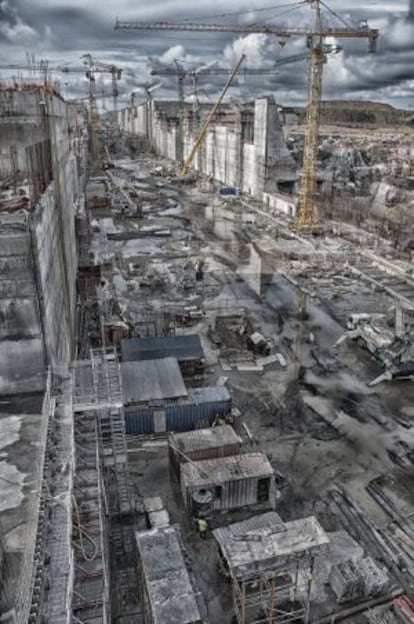Sacyr finds Panama pride has plugged the flow of canal negotiations
After decades of bullying, adamant Panamanian authorities now refuse to budge Government officials demand Spanish-led consortium abides by rules of expansion contract


There are actually two Panamas – one where the lights of the tall skyscrapers pepper the night sky like twinkling stars; where vehicles brisk by with their radios turned up full blast; and where young men, acting as street barkers, willing to help the newly arrived tourist. “Where are you going?” asks one. “I can get you anything you want – some fun, some women. Anything for you, buddy.”
Then there is the other Panama: the pride of the isthmus – the canal zone – run by engineers educated at world-class universities; the strip where hard negotiations take place, leaving no time for frivolity. It is also where Sacyr, the Spanish construction giant, which is head of the Grupo Unidos por el Canal (GUPC) consortium that is expanding the canal, has collided with the men of this determined Panama.
Work on amplifying the 100-year-old waterway that connects the Pacific with the Caribbean has nearly stopped as the consortium tries to resolve a month-long dispute with the Panama Canal Authority (PCA) over $1.6 billion (some 1.2 billion euros) in cost overruns to build a new set of locks. Panamanian authorities believe that extra costs are not justified and have refused to put up any more money.
Technicians from other countries, who should be working around the clock to finish the project to meet next year’s deadline, spend their mornings jogging and while away the afternoons in Panama City. This is their daily routine as they wait for a solution. Meanwhile, cranes and gigantic sacks of cement can be seen abandoned on the side of the construction sites.
“They are so use to dealing with corrupt and spendthrift Latin American governments that they have no respect for the people,” said one Panamanian official who has been at the negotiating table in reference to the Sacyr-led consortium.
A member of the GUPC consortium – which includes the Italian firm Impregilo, the Belgium company Jan de Nul and the Panamanian Cusa – claims that the PCA doesn’t understand the business at hand.
“They are experts in transporting vessels from one side to the other, but when it comes to the construction business, they have no idea. The costs are justified but their unwillingness to discuss the issue at this stage is very unusual,” the GUPC representative says of the PCA.
Cranes and gigantic sacks of cement can be seen abandoned at the construction sites.
At the head of the PCA is Jorge Quijano, a deep-rooted nationalist who has worked in the canal zone since the 1970s. Legend has it that Quijano knows “every screw” of the waterway. In the 1990s, he was part of the clique of workers known as La Matraca, who opposed every decision made by US officials who were running the canal before it was transferred to Panama on December 31, 1999.
In 1903, Panama, with encouragement from President Teddy Roosevelt, seceded from Colombia. The then-infant government gave a large strip dividing the country to the United States so that the canal could be built.
Quijano recalls how humiliating it was to cross foreign territory every day to get to his office.
During its 85 years of US ownership, the Panama Canal reported $1.6 billion in profits. In the past 14 years, some $8.6 billion went to the Panamanian government’s coffers.
“We have raked in very high profits and have had good results, but that doesn’t mean we are going to negotiate outside of the contract,” Quijano said. “That money belongs to no one except the Panamanian people.”
Quijano recalls an incident when he told Impregilo CEO Paolo Moder that he wasn’t going to break the contract. “He told me ‘well, change the law.’ I told him: you are insulting me.”
For now, there is no turning back.
Last week, an agreement was nearly reached when insurer Zurich tried to mediate via an offer to free up the $400 million that the two parties have paid as a bond with both sides each putting up an extra $100 million. The idea was to ensure there was enough cash flow so that the expansion work could continue, but no deal was reached and the original January 20 deadline to abandon the project was pushed back until February 1.
Historically, Panamanians know what it is to grovel and agree to the demands of foreign companies, but this time they are refusing to bow down.
In June 1980, national boxing champion Roberto Durán defeated Sugar Ray Robinson in a memorable match known as “the brawl of Montreal” capturing the WBC Welterweight title. But in a rematch in November, Durán surprisingly walked away during the eighth round.
“We carry this with us all the time, and we will never forget it,” said one Panamanian construction worker as he held his hand to his heart. Until the dispute is resolved, he won’t return to his job.
The controversy has been the center of conservations at the World Economic Forum in Davos. Panamanian President Ricardo Martinelli has had to assure international leaders that the work will continue and that maritime trade will not be jeopardized.
They are experts in transporting vessels, but when it comes to construction, they have no idea”
But according to the Dispute Adjudication Board (DAB) mediation panel, which was set up to help resolve such conflicts by the PCA, if the contract with the Sacyr group is broken, the work would not be completed until between 2018 and 2020, rather than 2015 as scheduled.
Spanish Public Works Minister Ana Pastor has also offered to mediate.
“There should not be any type of negotiations outside the contract, said Panamanian Foreign Minister Jorge Eduardo Ritter. “This isn’t a diplomatic dispute. These types of mediations don’t contribute to anything.”
Some 8,000 Spaniards were part of the quilt of nationalities that helped to build the canal between 1904 and 1914. Later, other generations of Spaniards came to set up hotels plus other businesses for tourists and to sell furniture. The bonds between Spain and Panama have always been strong.
Panama’s most famous soccer player, Julio César Dely Valdés, played for both Oviedo and Málaga from 1997 to 2003. He lives in Panama but still travels to Spain frequently. “This problem has really been blown out of proportion. There has to be a final solution. These are both nations that must come to an agreement,” Dely Valdés said, adding that this conflict is more than just a controversy between individuals.
At Taberna 21, in downtown Panama City, live bands play all types of music, from rock to funk. Owner Hilario Suárez, a native of Asturias, sips wine as he recalls how last year it occurred to him to formally nominate the Panama Canal for the Prince of Asturias Prize as a candidate in the international cooperation category.
“It unites everyone – Jews Arabs, Spaniards and Panamanians. If that isn’t Concordia, then let God be the judge of that,” he said
Those were definitely other times.
Tu suscripción se está usando en otro dispositivo
¿Quieres añadir otro usuario a tu suscripción?
Si continúas leyendo en este dispositivo, no se podrá leer en el otro.
FlechaTu suscripción se está usando en otro dispositivo y solo puedes acceder a EL PAÍS desde un dispositivo a la vez.
Si quieres compartir tu cuenta, cambia tu suscripción a la modalidad Premium, así podrás añadir otro usuario. Cada uno accederá con su propia cuenta de email, lo que os permitirá personalizar vuestra experiencia en EL PAÍS.
¿Tienes una suscripción de empresa? Accede aquí para contratar más cuentas.
En el caso de no saber quién está usando tu cuenta, te recomendamos cambiar tu contraseña aquí.
Si decides continuar compartiendo tu cuenta, este mensaje se mostrará en tu dispositivo y en el de la otra persona que está usando tu cuenta de forma indefinida, afectando a tu experiencia de lectura. Puedes consultar aquí los términos y condiciones de la suscripción digital.
Últimas noticias
Most viewed
- Why we lost the habit of sleeping in two segments and how that changed our sense of time
- Charles Dubouloz, mountaineering star, retires at 36 with a farewell tour inspired by Walter Bonatti
- Venezuela faces its most tense Christmas yet
- CBS in crisis after pulling a report on Trump’s deportations to El Salvador (which later leaked online)
- Bukele clan fumes over investigation exposing their new wealth








































